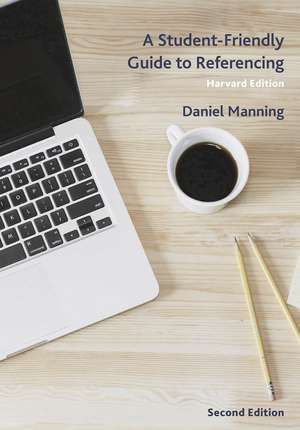A Student-Friendly Guide to Referencing: Harvard Edition
Autor Daniel Manningen Limba Engleză Paperback – 14 oct 2020
Preț: 217.43 lei
Nou
Puncte Express: 326
Preț estimativ în valută:
41.61€ • 45.18$ • 34.95£
41.61€ • 45.18$ • 34.95£
Carte tipărită la comandă
Livrare economică 22 aprilie-06 mai
Preluare comenzi: 021 569.72.76
Specificații
ISBN-13: 9781352010930
ISBN-10: 1352010933
Pagini: 184
Ilustrații: 10 bw illus
Dimensiuni: 178 x 254 mm
Ediția:2
Editura: Bloomsbury Publishing
Colecția Red Globe Press
Locul publicării:London, United Kingdom
ISBN-10: 1352010933
Pagini: 184
Ilustrații: 10 bw illus
Dimensiuni: 178 x 254 mm
Ediția:2
Editura: Bloomsbury Publishing
Colecția Red Globe Press
Locul publicării:London, United Kingdom
Caracteristici
Shows students how to build, format and punctuate Harvard-style citations and references for the twenty-five most common source types
Notă biografică
Daniel Manning leads the Curriculum Development Team at the University of Nottingham Ningbo in China. He has tutored learners in Europe, Asia, South America and the Middle East, and specialises in English for Academic Purposes (EAP).
Cuprins
Unit 1 Using this Guide 1.1 Introducing Referencing 1.2 Choosing the Harvard Style 1.3 Guidance for Students and Tutors Unit 2 Understanding Sources 2.1 Identifying Source Types 2.2 Locating Source Details 2.3 Judging Source Value Unit 3 Conducting Academic Research 3.1 Finding Academic Sources 3.2 Using the Internet and the Library 3.3 Searching with Boolean Operators Unit 4 Applying Study Skills 4.1 Keeping Detailed Notes 4.2 Paraphrasing and Summarising 4.3 Acknowledging Source Authors Unit 5 Citing Source Information 5.1 Writing Harvard Citations 5.2 Varying Citation Types 5.3 Citing Quotations Unit 6 Creating Matching References 6.1 Writing Harvard References 6.2 Arranging Reference Lists 6.3 Using Referencing Software Unit 7 Solving Referencing Problems 7.1 Referencing Similar Source Details 7.2 Referencing Missing Source Details 7.3 Identifying and Referencing Authors Unit 8 Editing and Proofreading 8.1 Balancing Authors' Voices 8.2 Selecting Reporting Verbs 8.3 Formatting the Final Draft Unit 9 Following Academic Conduct 9.1 Avoiding Collusion 9.2 Preventing Plagiarism 9.3 Checking for Similarity Unit 10 The Quick-Reference Guide 10.1 Books (Digital) 10.2 Books (Printed) 10.3 Books with Authors and Editors 10.4 Books with Contributing Authors 10.5 Books with Different Editions 10.6 Conference Papers (Digital) 10.7 Conference Papers (Printed) 10.8 Dissertations and Theses (Digital) 10.9 Dissertations and Theses (Printed) 10.10 Dissertations and Theses (Unpublished) 10.11 Graphic Data in Books 10.12 Graphic Data Online 10.13 Journal Articles (Digital) 10.14 Journal Articles (Printed) 10.15 Magazine Articles (Digital) 10.16 Magazine Articles (Printed) 10.17 Newspaper Articles (Digital) 10.18 Newspaper Articles (Printed) 10.19 Photographs (Digital) 10.20 Podcasts 10.21 Reports (Digital) 10.22 Reports (Printed) 10.23 Social Networking Sites 10.24 Tutor Handouts (VLEs) 10.25 Web Pages Glossary Index.
